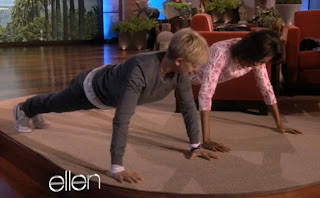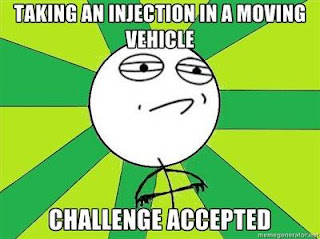http://www.bellenews.com/2012/02/02/world/us-news/michelle-obama-completed-25-push-ups-on-ellen-degeneres-show/
The image I chose for my final blog post is of the First Lady Michelle Obama engaged in a push-up competition with Ellen DeGeneres on the Ellen show. I chose this specific image because, simply put, I think that its awesome. The Obamas are changing the face of American politics with the way they carry themselves, and for their "approachable" personas. This photo was taken during the First Lady's California tour, promoting physical health and fitness. While it is quite common for Ellen to challenge her guests to perform various bizarre and embarrassing tasks on her show, I admire the fact that someone with such a prestigious title would be so easy going and willing to look silly on national television.
This image made me think of our Visual Analysis class because not only have we spent a great deal of time talking about the Obamas and the way they are portrayed in the media, but also because while this is a fairly candid shot, I think it encapsulates exactly how the First Lady wishes to be portrayed. Michelle Obama made her appearance on Ellen in dark jeans and a casual pink top. She certainly could have dressed up and presented herself in a more 'polished' or business-like way, however she was trying to convey that she is really like an average American while she was talking about the importance of physical activity. With this more relaxed appearance, she is more easily able to relate to the busy working moms, and the demographic that would be watching Ellen. It also helps her campaign message to show that she actually does the activities she is endorsing.
This class has really changed the way I perceive advertisements and documentary photographs. I think its incredible that an entire argument can be constructed and presented with strategically placed wording and images. While I was obviously aware that advertisements were designed to appeal to the audience and persuade them to buy the product, I had never really considered the extent to which they are manipulative. Now, when I see an ad, I look specifically at its layout, colouring and font contrasts. This course has really opened my eyes to various career paths as well, that deal with public relations and image consulting. This was also my first time blogging, and I found it to be a really great way to make your opinion heard on an issue. I hope to continue this blog after the school year finishes, and to continue thinking critically about what is presented to me in the media.






